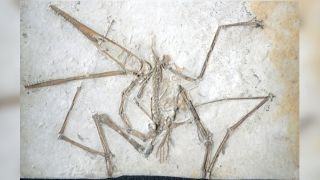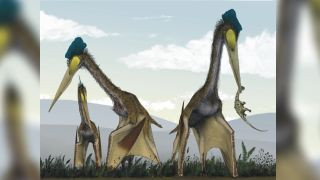Pterosaurs are often mistakenly called flying dinosaurs. However, while they lived during the same period as dinosaurs, they were not dinosaurs. They were flying reptiles, belonging to the order Pterosauria. The term “pterodactyl” is commonly used to refer to these creatures, but scientists prefer to use specific genera names like Pterodactylus and Pteranodon.
 Fossil of a pterosaur in rock
Fossil of a pterosaur in rock
A fossil specimen of Pterodactylus antiquus. (Image credit: teven U. Vidovic/David M. Martill/Matthew Martyniuk/CC BY 3.0)
Understanding Pterosaurs: More Than Just “Flying Dinosaurs”
Over 130 different types of pterosaurs have been identified, inhabiting diverse locations across the globe. They first appeared in the late Triassic Period and thrived until the end of the Cretaceous period (228 to 66 million years ago), coinciding with the dinosaurs’ extinction. Importantly, birds did not evolve from pterosaurs, but rather from small, feathered dinosaurs.
The Discovery and Naming of Pterosaurs
The first pterosaur, Pterodactylus, was discovered in 1784 and initially mistaken for a marine animal. In 1801, it was correctly identified as a flying creature, and the term “Ptero-dactyle” was coined in 1809. As more distinct genera were discovered, the scientific community shifted to using specific names, but “pterodactyl” remains the popular term.
The Anatomy of a Pterosaur: Wings and More
The name “pterodactyl,” meaning “winged finger,” aptly describes their unique anatomy. Their wings consisted of a membrane of skin and muscle stretching from an elongated fourth finger to their hind limbs. Additional membranes existed between their shoulders and wrists, and some even had a membrane between their legs, potentially incorporating their tail.
 An illustration of Quetzalcoatlus northropi
An illustration of Quetzalcoatlus northropi
An artist illustration of Quetzalcoatlus northropi. (Image credit: Mark Witton/Darren Naish/ CC BY 3.0)
Pterosaur Characteristics: Size and Physical Features
Pterosaurs varied greatly in size. The smallest, Nemicolopterus crypticus, had a wingspan of only 10 inches, while the largest, Quetzalcoatlus northropi, boasted a wingspan reaching 36 feet. Pteranodon, with a wingspan of 9 to 20 feet, was another large pterosaur known for soaring over oceans to hunt fish.
Physical characteristics also differed widely. Many pterosaurs had long necks and skulls filled with needle-like teeth, while others, like Quetzalcoatlus northropi, were toothless. A notable feature was the presence of crests on their heads, which varied in size and composition, likely serving the purpose of sexual selection rather than flight or heat regulation.
Pterosaur Diet and Lifestyle
Pterosaurs were primarily carnivores, with diets varying based on habitat. Terrestrial pterosaurs hunted small prey like lizards and insects, while aquatic species consumed fish and other marine life. Interestingly, the fossil record suggests that juvenile pterosaurs, particularly aquatic ones, faced a higher risk of drowning due to underdeveloped muscles and flying skills. Recent research on fossilized teeth has shed light on the diet of certain pterosaur species, revealing surprising insights into their feeding habits. For example, the Dimorphodon, originally thought to be a fish-eater, likely consumed insects and land vertebrates based on tooth wear patterns.
Conclusion: The Fascinating World of Pterosaurs
While often confused with flying dinosaurs, pterosaurs were a distinct group of flying reptiles that coexisted with dinosaurs. Their unique anatomy, diverse characteristics, and varied lifestyles make them a captivating subject of study, shedding light on the rich biodiversity of prehistoric Earth.